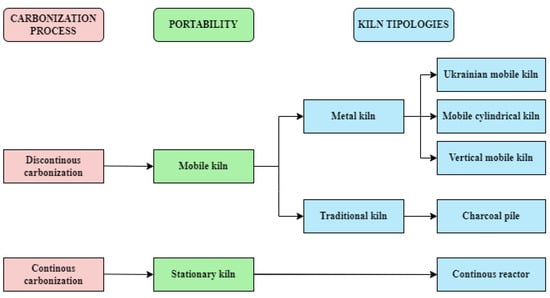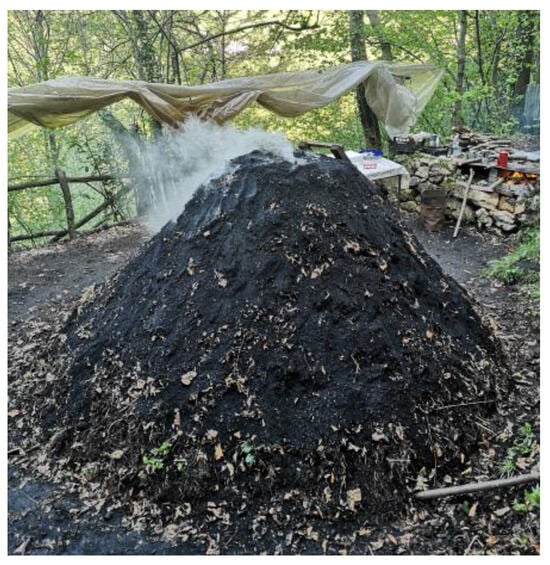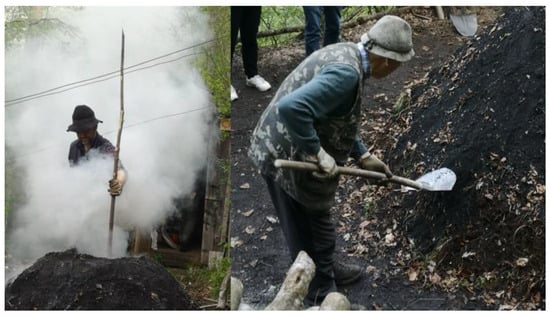You're using an outdated browser. Please upgrade to a modern browser for the best experience.

Submitted Successfully!
Thank you for your contribution! You can also upload a video entry or images related to this topic.
For video creation, please contact our Academic Video Service.
| Version | Summary | Created by | Modification | Content Size | Created at | Operation |
|---|---|---|---|---|---|---|
| 1 | Alessio Mencarelli | -- | 1977 | 2023-11-28 15:18:33 | | | |
| 2 | Sirius Huang | Meta information modification | 1977 | 2023-11-29 02:08:49 | | |
Video Upload Options
We provide professional Academic Video Service to translate complex research into visually appealing presentations. Would you like to try it?
Cite
If you have any further questions, please contact Encyclopedia Editorial Office.
Mencarelli, A.; Cavalli, R.; Greco, R.; Grigolato, S. Technical–Operational Characteristics of Charcoal Production Systems. Encyclopedia. Available online: https://encyclopedia.pub/entry/52148 (accessed on 05 January 2026).
Mencarelli A, Cavalli R, Greco R, Grigolato S. Technical–Operational Characteristics of Charcoal Production Systems. Encyclopedia. Available at: https://encyclopedia.pub/entry/52148. Accessed January 05, 2026.
Mencarelli, Alessio, Raffaele Cavalli, Rosa Greco, Stefano Grigolato. "Technical–Operational Characteristics of Charcoal Production Systems" Encyclopedia, https://encyclopedia.pub/entry/52148 (accessed January 05, 2026).
Mencarelli, A., Cavalli, R., Greco, R., & Grigolato, S. (2023, November 28). Technical–Operational Characteristics of Charcoal Production Systems. In Encyclopedia. https://encyclopedia.pub/entry/52148
Mencarelli, Alessio, et al. "Technical–Operational Characteristics of Charcoal Production Systems." Encyclopedia. Web. 28 November, 2023.
Copy Citation
The global charcoal trade is steadily growing, with high-income countries importing significant quantities of this material from regions where its production is often associated with severe environmental issues, including forest overexploitation, illegal logging, and environmental pollution. Promoting local charcoal production in high-income countries is crucial to addressing these challenges.
biomass
carbonization
pyrolysis
supply chain
environmental impact
air emissions
1. Introduction
Traditional charcoal production remains a small-scale activity predominantly practiced in local mountain areas. In recent years, novel prototypes of modern charcoal-making systems have emerged to address the limitations associated with traditional techniques, ultimately enhancing efficiency and productivity. The main technical and operational characteristics of the carbonization systems currently available in Italy are illustrated below (Figure 1).

Figure 1. Classification of charcoal production systems currently used in Italy.
2. Traditional System (Charcoal Pile)
Although on a local scale, the setting up of the charcoal pile presents little difference based on the traditions and experience of the operators, the process is performed according to the following procedures.
The production of charcoal using the traditional technique involves the initial preparation of the area where the charcoal pile will be built. In the past, these were located inside the forest to reduce the distance of wood transportation and near a watercourse to facilitate the extinguishing of the charcoal pile. To create a flat surface on slopes, the ground is leveled by removing the portion of land uphill and repositioning it on the downhill side [1]. The base of the charcoal pile typically has a circular or, more frequently, elliptical shape to facilitate charcoal harvesting [2], developing vertically up to presenting a conical or hemispherical shape (Figure 2). The size of the charcoal pile is proportional to the amount of stacked wood material.

Figure 2. Traditional charcoal pile in Veneto (Italy).
In the structure center, a chimney is made by arranging the larger logs horizontally and creating a square structure or, even more simply, tying poles together vertically of variable height, usually around 2–3 m [1][3][4]. The chimney is filled with easily combustible material to speed up and facilitate the ignition of the carbonization process. Around the chimney, the larger logs (diameter > 15 cm) are stacked in the internal part of the structure, while the external part is filled using small-sized material arranged perpendicularly (diameter < 5 cm) [3]. The progressive deposition of the wood determines the typical final hemispherical shape. To prevent contact between oxygen and the material and the entry of water from rainfall, the pile is covered with a mixture of earth, branches, and leaves for a thickness ranging from 5 to 20 cm [1][4][5][6].
The carbonization process is started by pouring embers through the chimney [1][7]. Being an artisanal process, the monitoring of the carbonization process is based exclusively on the experience of the operators. To control the air inside the pile, which regulates the combustion process, holes are opened and closed at the base of the charcoal pile [6] (Figure 3). The wrong aeration could lead to the development of flames causing the combustion of the material, while insufficient aeration could cause the process to stop.

Figure 3. Carbonization process monitoring by the operators: on the left, the operator controls the ignition of the charcoal pile; on the right, the operator covers the base of the charcoal pile with earth to prevent air entrance.
The duration of carbonization is proportional to the volume of wood material used and is conditioned by climatic conditions, the moisture content of the material, and the experience and skill of the operators. For small charcoal piles, the production cycle takes at least one day, but, more frequently, it takes from 3 to 4 days, while for large piles, the process can take from 10 to 20 days [1][4][5][7][8]. The end of the carbonization process is regulated by the color change of the exhaust fumes [7]. In the first phase of the carbonization process, the smoke coming out of the chimney and the holes is white, indicating the evaporation of the water contained inside the wood [9]. As the process progresses, the structure gradually loses volume and shrinks in size. The presence of light blue smoke indicates the end of the carbonization process and the beginning of the cooling phase [1][9][10]. In this phase, the temperature of the material gradually decreases naturally, requiring a lot of time depending on the geometry and dimensions of the pile, the quantity of material, and the atmospheric conditions [10]. Long times are needed to stabilize the charcoal, as a sudden entry of air could cause the combustion of the material [11]. To speed up the process, earth or water is used to lower the temperature and extinguish any embers still present [3]. Finally, the charcoal produced is collected and, once the earth has been removed, packaged for transport.
3. Modern Charcoal Kilns
3.1. Ukrainian Mobile Kiln
The paper by Picchio et al. [12] describes the characteristics and performance of a modern Ukrainian mobile horizontal kiln for charcoal production. The kiln presents a metal structure placed on a sled for facilitating transport using a tractor or truck. The woody raw material is manually loaded inside the carbonization chamber through a front hatch. At the rear of the kiln, there is a system for collecting the liquids resulting from the pyrolysis, preventing their dispersion in the soil, and a chimney for the release of the gases used for monitoring the process. As for the traditional charcoal kiln, the carbonization process is controlled based on the observation of the color of the smoke. In the front part of the kiln, there is a small combustion chamber where firewood is loaded, whose combustion is used for heating the material igniting the process. The oxygen entry inside the chamber is regulated by opening and closing appropriate vents positioned on the kiln sides. Once the process is complete, the charcoal produced is unloaded manually from the front hatch. Moreover, in this case, the carbonization must be monitored by the operator for the entire duration of the process, but its presence can be discontinuous.
3.2. Mobile Cylindrical Kiln
Based on the previous kiln, the same authors developed a new prototype of a cylindrical steel charcoal kiln [3]. Like the previous one, the kiln is installed on a sled to facilitate transport. The kiln structure is insulated to reduce heat loss during the process and improve the circulation of the pyrolysis gases, allowing for more homogeneous carbonization. The kiln has a loading capacity of approximately 5 m3. In the front and rear parts of the cylindrical structure, there are two loading doors with hermetic closures that can be opened in both directions, facilitating the loading and unloading operations. The kiln structure was designed to mechanically facilitate the insertion of wood using a tractor or forklift, allowing for a significant speeding up of loading operations and increasing productivity. Similarly, to the Ukrainian mobile kiln, in the front part of the kiln, there is a small combustion chamber fueled by firewood to provide the required heat for the whole process. The oxygen entry into the carbonization chamber is regulated by opening and closing vents located on the kiln sides and in the closing compartment of the ash collection chamber. The pyrolysis liquids are collected inside a tank whose unloading is facilitated by the presence of a tap, preventing their dispersion on the ground. In the rear part of the kiln, a condensation chamber equipped with a chimney is present. An operator must be discontinuously present during the process. The carbonization is monitored using laser thermometers to measure the temperatures inside the kiln. The visual analysis of the fume color resulting from the chimney further supports the monitoring of the process trend.
3.3. Vertical Mobile Kiln
Different from the previous ones, Picchio et al. [13] have developed a new prototype of a vertical mobile kiln. The kiln consists of a cylindrical steel carbonization chamber that performs both direct carbonization of the material loaded inside the chamber and indirect carbonization by inserting special cylindrical containers into the chamber. The carbonization chamber is closed at the top by a lid where a chimney is positioned centrally. On the side is present an additional chimney for collecting the gases released during the carbonization coming from three ducts placed below the carbonization chamber when using the cylindrical containers. In the front part, there is a combustion chamber where firewood is loaded, whose combustion is used to provide the heat necessary for the ignition of the process. Like the previous one, ash and liquids generated during charcoal production are collected in dedicated structures, while fumes are released into the atmosphere.
The direct carbonization of the raw biomass guarantees greater productivity as it exploits the full volume of the carbonization chamber. Inside, there can be stowed about 450–600 kg of logs of dimensions between 100–120 cm, which are arranged vertically and uniformly to ensure regular carbonization. To prevent the combustion of the material deriving from flames generated in the ignition chamber, the carbonization chamber is shielded by a fire-cutting plate. During indirect carbonization, three cylindrical containers are positioned inside the carbonization chamber. This is to further prevent direct contact with the flames generated by the thermal unit. In this case, the ignition of the process occurs through an airflow that circulates in the material using a vacuum system without direct contact with the flame. In addition to logs, containers can be filled with smaller materials, such as wood chips. Compared to the direct process, it has a lower load capacity, ranging between 190–280 kg.
Direct carbonization allows for the greater production of charcoal despite a greater energy consumption and a longer production duration. According to the authors, this process is better suited to the production of barbecue charcoal, while the indirect one is better suited to the production of biochar to be used in agriculture. In both processes, the loading and unloading of the material is conducted manually.
As for the previous ones, the carbonization process is monitored using the visual support of the color of the fumes. It is possible to measure the temperature inside the combustion chamber or cylindrical containers by inserting a probe or laser thermometer through an inspection hole. The process progress and oxygen entry are regulated by the operator by opening and closing the inlets present in the kiln.
3.4. Continuous Reactor
The development of highly technological kilns requires huge investments that are often not compatible with the financial resources of small and medium-sized Italian forestry enterprises. To provide a further tool for the energy valorization of biomass, RE-CORD® has developed a biomass carbonization reactor (CarbOn, patent IT1429282) for charcoal production [14][15][16]. The material obtained can be used in agriculture as a soil amendment [17], as active carbon [18], for the metallurgical industry [19], and for barbecue [15]. The kiln is composed of a vertical steel cylinder reactor with a capacity of 50 kg h−1 of biomass. The carbonization process is conducted continuously at atmospheric pressure with controlled oxygen concentration and with a temperature range between 450–700 °C [15].
Wood is manually loaded through a gate valve placed in the top part of the reactor. After the ignition of the process, the carbonized material and the pyrolysis gases are deposited in the lower part of the reactor. The charcoal is removed through a hopper placed below the reactor, which involves the carbonized material on a screw. Its rotation regulates the residence time of the material. The screw is cooled with water to reduce the charcoal temperature, conveying the materials into barrels with a capacity of 0.2 m3 for the collection. Since the removal of the pyrolysis gases does not take place at the bottom of the solid bed but above it, this leads to the presence of an oxygen-rich zone above the gas extraction point and, below it, a zone with a lower oxygen concentration. The temperature of the zones is monitored using thermocouples equipped with probes distributed both in the oxygen-rich zone (three probes) and the low oxygen concentration zone. The extracted gases, whose temperature is monitored with additional thermocouples to avoid tar condensation, pass through a cyclone for dust removal, an ejector, and finally burn in a torch.
References
- Benatti, A.; Bal, M.; Allée, P.; Bosi, G.; Dallai, D.; Mercuri, A.M. Charcoal Kilns in the Northern Apennines (Italy): Forest Exploitation by Past Societies in Mountain Areas. IANSA 2018, 9, 169–178.
- Carrari, E.; Ampoorter, E.; Bottalico, F.; Chirici, G.; Coppi, A.; Travaglini, D.; Verheyen, K.; Selvi, F. The Old Charcoal Kiln Sites in Central Italian Forest Landscapes. Quat. Int. 2017, 458, 214–223.
- Picchio, R. Guidelines for Wood Carbonization with Mobile Kilns (Linee Guida per la Carbonizazione di Legna con Forni Mobili), Viterbo, 2018.
- Menemencioglu, K. Traditional Wood Charcoal Production Labour in Turkish Forestry (Çankırı Sample). J. Food Agric. Environ. 2013, 11, 1136–1142.
- Seboka, Y. Charcoal Production: Opportunities and Barriers for Improving Efficiency and Sustainability. In Bio-Carbon Opportunities in Eastern & Southern Africa; Harnessing Carbon Finance to Promote Sustainable Forestry, Agro-Forestry and Bio-Energy; United Nations Development Programme: New York, NY, USA, 2009; pp. 102–126.
- FAO. Industrial Charcoal Making; Food and Agriculture Organization of the United Nations: Rome, Italy, 1985.
- Berrocal-Mendéz, N.; Moya, R. Production, Cost and Properties of Charcoal Produced after Logging and Sawing, by the Earth Pit Method from Tectona Grandis Wood Residues. J. Indian Acad. Wood Sci. 2022, 19, 121–132.
- Di Fazio, S.; Laudari, L.; Modica, G. Heritage Interpretation and Landscape Character in the Forestry District of Serra San Bruno (Calabria, Italy). In Proceedings of the XVIIth World Congress of the International Commission of Agricultural Engineering (CIGR), Québec City, QC, Canada, 13–17 June 2010.
- Foley, G. Charcoal Making in Developing Countries; Earthscan Pubns Ltd.: London, UK, 1986.
- Rodrigues, T.; Junior, A.B. Technological Prospecting in the Production of Charcoal: A Patent Study. Renew. Sustain. Energy Rev. 2019, 111, 170–183.
- de Oliveira Vilela, A.; Lora, E.S.; Quintero, Q.R.; Vicintin, R.A.; Pacceli da Silva e Souza, T. A New Technology for the Combined Production of Charcoal and Electricity through Cogeneration. Biomass Bioenergy 2014, 69, 222–240.
- Picchio, R.; Pari, L.; Venanzi, R.; Latterini, F.; Picchio, R.; Pari, L.; Venanzi, R.; Latterini, F.; Suardi, A.; Alfano, V.; et al. A New Mobile Kiln Prototype for Charcoal Production. In Proceedings of the 28th European Biomass Conference and Exhibition, Online, 6–9 July 2020.
- Picchio, R.; Venanzi, R.; Lo Monaco, A.; Tocci, D.; Di Marzio, N.; Mercurio, R. Diversification of Production and By-Products. In The Fruit Chestnut. Ecology, Parasitic Adversities, Innovative Mechanization; 2022; pp. 110–126.
- Chiaramonti, D.; Prussi, M.; Nistri, R.; Pettorali, M.; Rizzo, A.M. Biomass Carbonization: Process Options and Economics for Small Scale Forestry Farms. Energy Procedia 2014, 61, 1515–1518.
- Rizzo, A.M.; Pettorali, M.; Nistri, R.; Chiaramonti, D. Mass and Energy Balances of an Autothermal Pilot Carbonization Unit. Biomass Bioenergy 2019, 120, 144–155.
- Rizzo, A.M.; Pettorali, M.; Prussi, M.; Nistri, R.; Pari, L.; Chiaramonti, D. Integration of SRF and Carbonization Plant for Small Forestry Farms. Energy Procedia 2017, 105, 212–217.
- Casini, D.; Barsali, T.; Rizzo, A.M.; Chiaramonti, D. Production and Characterization of Co-Composted Biochar and Digestate from Biomass Anaerobic Digestion. Biomass Convers. Biorefinery 2021, 11, 2271–2279.
- Duan, D.; Chen, D.; Huang, L.; Zhang, Y.; Zhang, Y.; Wang, Q.; Xiao, G.; Zhang, W.; Lei, H.; Ruan, R. Activated Carbon from Lignocellulosic Biomass as Catalyst: A Review of the Applications in Fast Pyrolysis Process. J. Anal. Appl. Pyrolysis 2021, 158, 105246.
- Dufourny, A.; Van De Steene, L.; Humbert, G.; Guibal, D.; Martin, L.; Blin, J. Influence of Pyrolysis Conditions and the Nature of the Wood on the Quality of Charcoal as a Reducing Agent. J. Anal. Appl. Pyrolysis 2019, 137, 1–13.
More
Information
Subjects:
Energy & Fuels
Contributors
MDPI registered users' name will be linked to their SciProfiles pages. To register with us, please refer to https://encyclopedia.pub/register
:
View Times:
973
Revisions:
2 times
(View History)
Update Date:
29 Nov 2023
Notice
You are not a member of the advisory board for this topic. If you want to update advisory board member profile, please contact office@encyclopedia.pub.
OK
Confirm
Only members of the Encyclopedia advisory board for this topic are allowed to note entries. Would you like to become an advisory board member of the Encyclopedia?
Yes
No
${ textCharacter }/${ maxCharacter }
Submit
Cancel
Back
Comments
${ item }
|
More
No more~
There is no comment~
${ textCharacter }/${ maxCharacter }
Submit
Cancel
${ selectedItem.replyTextCharacter }/${ selectedItem.replyMaxCharacter }
Submit
Cancel
Confirm
Are you sure to Delete?
Yes
No




